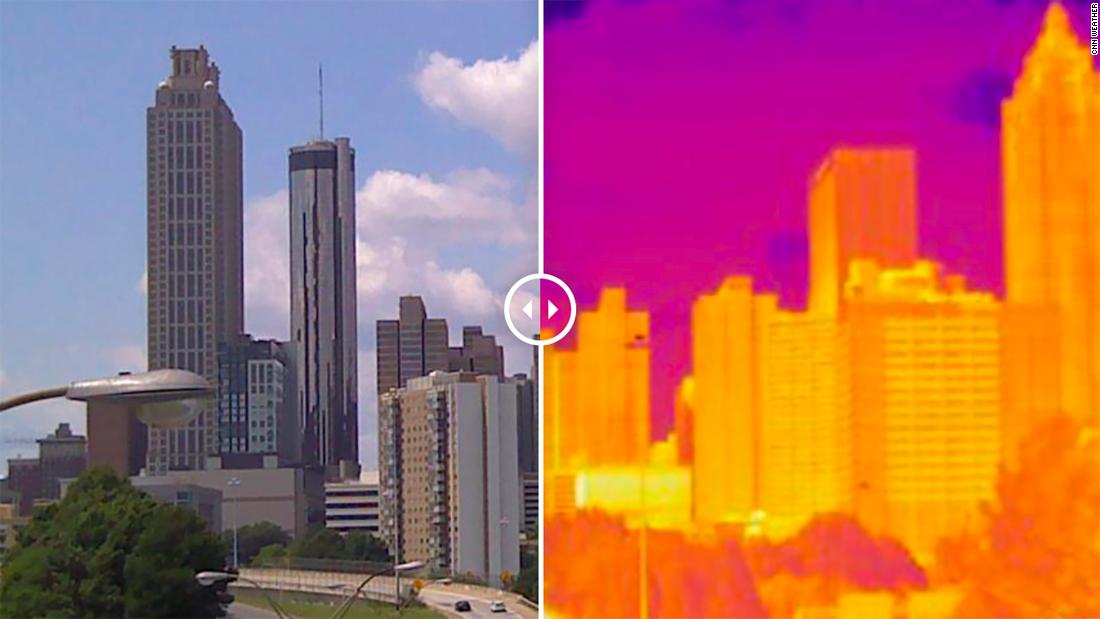Urban heat islands in Atlanta highlight areas that are affected by redlining
“The windows are painted closed,” said Scott. “We come outside to sleep at night because it’s too hot inside.”
“It’s just so hot,” Scott said as she wiped the sweat from her forehead.
Although the racist practice was banned in the late 1960s, its effects can still be seen.
Extreme heat today threatens the health and well-being of underserved communities, while predominantly white neighborhoods reap the cooler benefits of decades of investment.
“I went shopping the other day and thought I was going to pass out.” Scott told CNN. She said she suffered from high blood pressure and diabetes, which are underlying health conditions made worse by excessive heat.
For Scott and so many other disadvantaged community members, keeping the lights on, let alone access to reliable air conditioning, is hard enough financially.
Confrontation with environmental racism
“When we think about global challenges like climate change, it is one of the issues that disproportionately affects black and other color communities,” said Jelks. “That’s why it’s very important that we sit at the table.”
Jelks and Guanyu Huang, Assistant Professor of Environmental and Health Sciences at Spelman College and local director of the Atlanta Heat Mapping Campaign, are both very passionate about the work. They hope the data will transform the city they both live in.
“So this data will actually help the people in Atlanta, especially those in the downtown or intercity area, the people who actually suffer from heat and don’t have access to an AC system,†said Huang.
Other cities that participated in NOAA’s heat mapping campaign have adopted the results and made changes, such as planting more trees or adding more parks in areas suffering from the worst heat.
The inequalities in the green area are noticeable as you traverse Atlanta. As you drive through Scott’s neighborhood, there are fewer and smaller parks than nearby neighborhoods, which are mostly white, and natural shade from trees is also lacking.
This study is personal
Brionna Findley, a former Atlanta resident and volunteer for the Urban Heat Islands Campaign, has an experience with inequality. She has seen firsthand that her community has no access to air conditioning and shaded green spaces.
Findley says she and her family survived countless Atlanta heat waves while they were there. And it just seems to get hotter.
“When I took the temperature for that particular day, we had higher temperatures when it came to areas with low trees, more infrastructure and more asphalt on the road,” Findley said. “It was extremely hot, you can feel it. It wasn’t anything that was hidden.
This campaign is personal to Findley after her own grandmother experienced signs of heat stroke.
“It was like one of the hottest days in Georgia. And we went out and went through the mall and had to go home because you could see one side of her face was going down. â€Findley explains. “She spoke indistinctly. It was very, very difficult to see. I was very scared.”
“She is fine. But we definitely don’t let her go outside that often, especially when it’s hot outside, â€said Findley. “Like Grandma, you have to stay inside today and do some activities inside.”
It could get worse
In Atlanta, the city now has an average of 11 90-degree or hotter days in summer compared to the old 30-year average. Salt Lake City has an average of 10 more days at 90 degrees or more, and Houston has gained nine days.
“If we bring together all of the data from all cities, it will be helpful for all levels of government at state and federal level to have a country-wide climate resilience plan. So that’s what we can do here, â€said Huang. “We can use it to do research, teach your classes on climate change, tell people that climate change is actually right there, right next to our neighborhood.”
Possible solutions for a better future
“I lived in New York and there were cold centers that the homeless could come to during the day to avoid being out in the heat, to drink water, maybe get a sandwich and a snack. And I haven’t never had that down here seen [in Atlanta]Said Scott. “I think you … [city planners] should plant trees in hot areas, especially near bus stops. I think they have to open some kind of center, you know, to keep people cool. ”
Covid-19 has also made unofficial cooling centers like libraries or shopping malls difficult to access, while before the pandemic they may have been more accessible to the general public. In some cases, Scott has found that these locations are simply closed.
Jelks said these communities need investments and solutions that don’t crowd them out.
“We can add new trees, but we need to make sure that there is political support to keep the people who are currently suffering from the lack of access to these amenities,” said Jelks. “We want to keep them in place and make sure they are not gentrified and driven out of their communities.”
CNN Health’s Jen Christensen contributed to this article.

